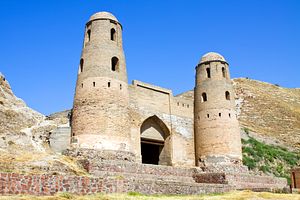Some links to check out over the weekend:
Earlier in the week I reported on Tajikistan’s government closing the central offices of the Islamic Renaissance Party of Tajikistan (IRPT) (after closing the oppositions party’s publishing arm). This is far from the beginning of the end of the IRPT; in fact, we’re seemingly nearing the end of the end for the region’s only legal religious party and a core piece of the peace treaty which ended the Tajik civil war. As the weekend approached, Tajikistan banned the IRPT–on account that the party is operating illegally, because most of its branch offices have been shut. The party claims its members have been intimidated into leaving. RFE/RL’s Tajik service has a worthwhile piece on the situation. The IRPT has been given 10 days to cease its activities.
This week news broke that Marinika Babanazarova, director of the world renowned Nukus Art Museum in Uzbekistan, had been dismissed. The story has been widely picked up–with pieces commenting on the situation in the usual places but also in art sections across major Western outlets. Here are two pieces worth reading to help get a broader view of why the firing of an art director is causing such an international fuss. The first, an opinion piece by Stephan Kinzer in the Boston Globe, draws attention first to the news last week that ISIS had destroyed the ancient ruins at Palmyra. Kinzer then writes that “a devil’s brew of greed and corruption threatens to turn Uzbekistan into the next ground zero of cultural vandalism.”
The second article worth reading relating to imperiled Central Asian art is a piece on Eurasianet that looks at the neglect of ancient treasures in Tajikistan:
Cyropolis, as classical authors knew the place where Istaravshan now stands, was founded by Achaemenid emperor Cyrus the Great as one of several defensive bulwarks against nomadic peoples inhabiting the steppes east of the Caspian Sea. Those defenses were not enough, however, to hold off the invading armies of Alexander the Great, who reduced Cyropolis to ruins when its residents put up fierce resistance.
Tajikistan’s government has for decades talked about honoring the country’s Persian past. But if the state of sites like those in Istaravshan is anything to go by, officials are better at talking up history than they are at preserving it.
A long list of fascinating kingdoms, people, cultures, myths and more originated in Central Asia–the crossroads of the world. Pieces of that past are somewhat unexplored, or difficult to access, and increasingly under threat.
In Tajikistan, while its Persian past is in peril, massive construction projects move ahead (remember that $100 million theater project launched earlier this year?). The Australian Institute of International Affairs has an article this week by Simon Henderson, that focuses on Tajikistan’s massive national tea house, what the author calls a symbol of the country’s folly:
The National Tea House is undoubtedly a spectacular building which is evocative of similar ostentatious buildings, such as the Palace of Versailles. However, in a country where poverty and food insecurity looms large it is a gross and unnecessary expense.
Henderson actually managed to get a tour of the interior in July. And while his guide pointed out the public areas–among them a movie theater and bowling alley–the costs far exceed what the average Tajik could afford. A bowling session costs 140 somoni, roughly $22.
































